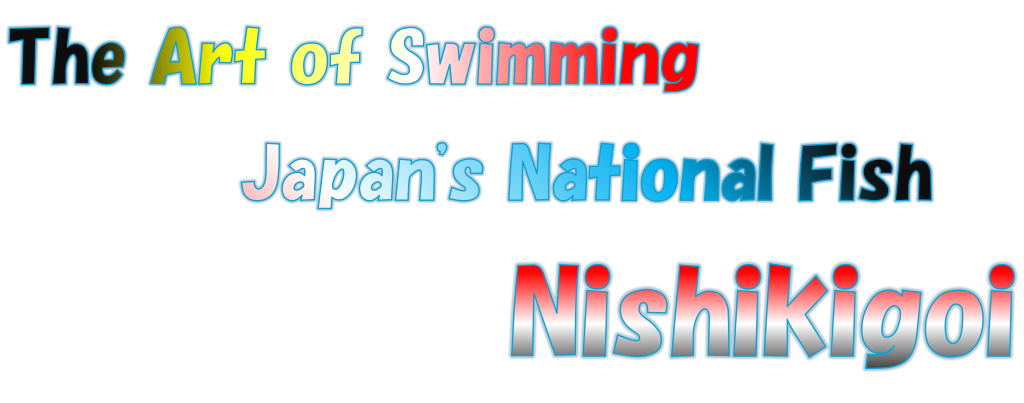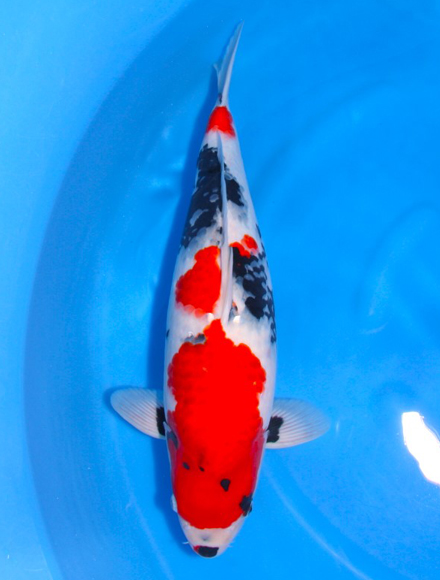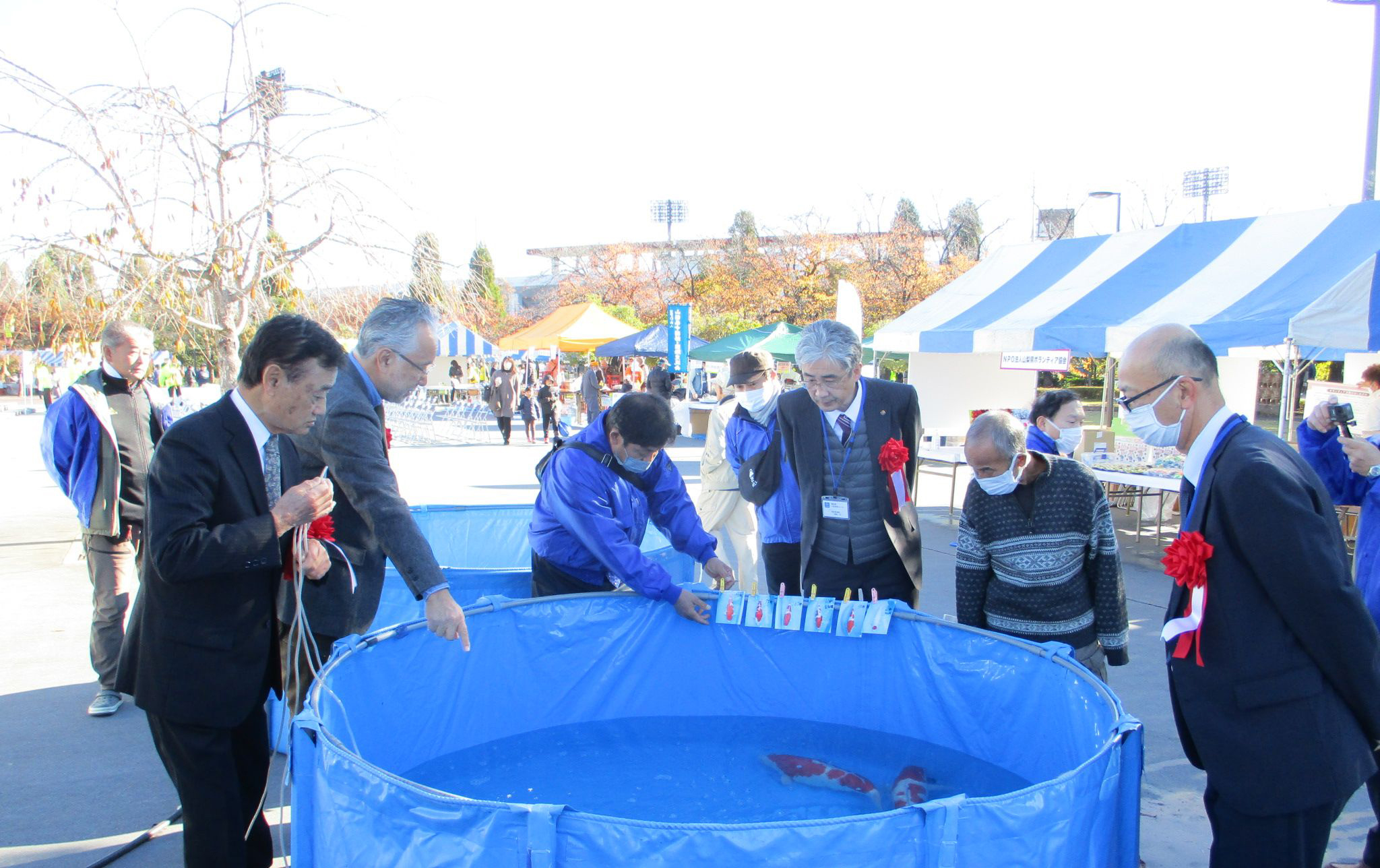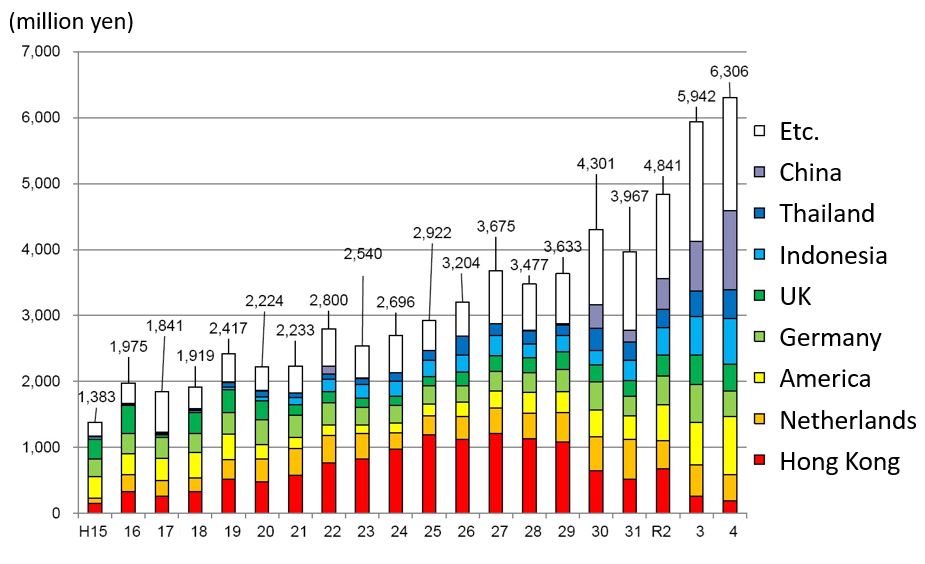



Nishikigoi of Yamanashi Prefecture
The cultivation of Nishikigoi in Yamanashi Prefecture began at the end of the Meiji period (1868-1912), and later became popular using pupae of silkworms, a byproduct of silk production, which have high nutritional value. In 1961, a hot spring suddenly bubbled up from a vineyard and became the present-day Isawa Onsen(hot spring). By the way, Niigata, the home of Nishikigoi, has very deep snow and it was difficult to keep Nishikigoi over winter, but when Nishikigoi were kept over winter around this hot spring, it was found that they were healthy and their color improved very much. This is the reason why full-scale Nishikigoi farming began in Yamanashi Prefecture, mainly in the Isawa and Kasugai areas. The groundwater in the Kofu Basin is warm and slightly alkaline, and it is said that the red color of Nishikigoi becomes brighter when they eat algae grown in this water.


(Kohaku, Taisho Sanshoku, Showa Sanshoku)
Swimming jewel “Nishikigoi”
Nishikigoi is one of the most popular ornamental fish in Japan, with vivid colors such as red, white, and black. Nishikigoi is also the only ornamental fish that was created by Japanese people. The scarlet carp, the ancestor of the Nishikigoi, is thought to have been born in the Edo period (1603-1868) as a result of a mutation in the common carp bred for food in the Yamakoshi region of Niigata Prefecture. The people of that time made repeated improvements in order to produce more rare and beautiful colored Koi, and by the beginning of the Showa period (1926-1989), three representative varieties of red, white, and black Koi were produced, which were later called "Gosanke" (the three representative varieties of Koi): Kohaku, Taisho Sanshoku, and Showa Sanshoku. Today, thanks to the efforts of breeders over the years, beautiful Nishikigoi are produced in Niigata Prefecture, where they originated, and in many other places in Japan, and it is said that there are more than 100 varieties.

"Kohaku" is a red pattern on a white background. The red is darker and brighter, the white is whiter, and a clear border between the red and white is considered excellent.
Although it is a simple color scheme, it is so profound that it is said, "Kohaku starts and ends with Kohaku," and various varieties have been created based on Kohaku.

"Taisho-Sanshoku" is a Kohaku and black Urushi-zumi Nishikigoi, named after the Taisho era in which it was produced.
The ideal Koi is one that has a balanced arrangement of lustrous Sumi based on the Kohaku pattern.

"Showa-Sanshoku" is a Nishikigoi that is characterised by a continuous form of Utsuri-zumi, named after the Showa period in which it was produced.
It is considered good if it has sumi curling from the belly to the back, and sumi with a face split in two, as if the face is split in two.
Photo credit: From the website of the All-Japan Nishikigoi Promotion Association

Nishikigoi breeding line chart(Source: New Japan Educational Books)
Nishikigoi Show
The Yamanashi Prefecture Nishikigoi Show celebrated its 50th anniversary in 2023.The first overall winner is awarded the Ministry of Agriculture, Forestry and Fisheries Prize, the second the Director General of the Fisheries Agency Prize, and the third the Governor of Yamanashi Prefecture Prize. In addition, because the beauty of Nishikigoi from Yamanashi Prefecture is highly evaluated, they have repeatedly won good results at national shows such as the All Japan Nishikigoi Show. At the show, several committee members judge the fish by size and variety, and the judging is based on body shape, color, and pattern.

- ○ Body shape: The most important item is the height and width of the body, and the balance of the body is also evaluated.
- ○ Color: Scarlet color should be deep, even and beautiful red, sumi color should be shiny and dark black, and the skin should be white like snow. It is also important that the color is clear and even.
- ○ Patterns: People have their own preferences for patterns, but a good balance of the front, back, left, and right is highly evaluated.
Production status in this prefecture
▼ Producers
There are seven Nishikigoi farmers in the prefecture, scattered throughout the Kofu Basin, mainly in the Kasugai and Isawa areas of Fuefuki city.
| No. | Name (Website) | Address | Phone | |
| 1 | Suien | suien0926@ yahoo.co.jp |
14 Kubonakajima, Isawa town, Fuefuki city | +81-55-262-9855 |
| 2 | Isawa Nishikigoi Center | mail@ inckoi.com |
142-2 Hatta, Isawa town, Fuefuki city | +81-55-262-4191 |
| 3 | Fish land Ishihara | fishland@ fish-pet.com |
3-5-40 Aioi, Kofu City | +81-55-233-5676 |
| 4 | Maruichi Sakuma | 5150sakuma@ gmail.com |
493 Karakashiwa, Isawa town, Fuefuki city | +81-55-262-3735 |
| 5 | Hiroi Koi Farm | yhiroi@ bd.wakwak.com |
192 Karakashiwa, Isawa town, Fuefuki city | +81-55-262-6159 |
| 6 | Maruyama Koi Farm | maruyama-koi.farm@ sky.plala.or.jp |
1,499-1 Ehara, Minami-Alps City | +81-55-282-0586 |
▼ Production results
Production has been on a slight downward trend due to the shift of sales destinations from domestic to exports. Especially since 2021, production has decreased due to the impact of the new coronavirus.
| 2016 | 2017 | 2018 | 2019 | 2020 | 2021 | 2022 | |
|---|---|---|---|---|---|---|---|
| Production amount (tons) | 26 | 27 | 26 | 26 | 23 | 16 | 16 |
| Production value (million yen) | 128 | 135 | 127 | 133 | 113 | 78 | 79 |
Reference: Yamanashi Prefecture Agriculture and Fisheries Production Value
▼ Export
The popularity of Nishikigoi has been increasing year by year, not only domestically but also internationally, and the export value of Nishikigoi from Japan has more than doubled in the past ten years. In 2022, Nishikigoi was added to the government's priority export items, and the terminology and varieties were defined in the Japanese Agricultural Standards (JAS), resulting in an export value of 6.3 billion yen, the highest ever. Nishikigoi has become a part of the Japan brand, and further expansion of exports is expected in the future.

Export value of Nishikigoi and other products from all over Japan (cited from the Fisheries Agency website)
In Yamanashi Prefecture, the Fisheries Technology Center issues export hygiene certificates to support smooth exports. (Interview: Yamanashi Fisheries Technology Center)
| Hygiene Certificate | 2016 | 2017 | 2018 | 2019 | 2020 | 2021 | 2022 |
|---|---|---|---|---|---|---|---|
| Number of certificates issued | 27 | 29 | 37 | 33 | 20 | 49 | 62 |
| Number of fish | 8,154 | 15,081 | 9,027 | 9,862 | 7,591 | 16,402 | 17,950 |

Number of Sanitary Certificates issued by Yamanashi Prefecture by exporting country in 2021
While some of Yamanashi Prefecture's Nishikigoi are great enough to win national championships, we also have a large selection of beautiful Nishikigoi that can be easily purchased at home. Why don't you try keeping Nishikigoi?
Link









